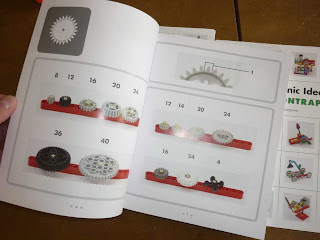
I've posted about Yoshihito Isogawa's Red, Blue, and Green books in older posts - his books are excellent resources but they've had one drawback - his books are published in Japan and can be hard to find (and expensive to obtain). And add to this the fact that most of the text in the books is written in Japanese.
Until now.
No Starch Press has just released three of Yoshihito's books - all of them are in full-color and the designs are divided up over Simple Machines, Fantastic Contraptions, and Wheeled Wonders.
For those new to Technic building, the Simple Machines book (Red title) is indispensable. It contains hundreds of small moving devices that can provide your robots with all sorts of new and unique behaviors. The book also introduces gears in a way that is easy to understand. Because English is not Yoshihito's native language, he has chosen instead to rely heavily on icons and graphics throughout the book that give you an idea of what a mechanism does. Take a look at some of the photos from inside the books and you'll see what I mean - even the Table of Contents uses the simple icons to convey the intent of a chapter or section of designs.
 The Wheeled Wonders and Fantastic Contraptions books (Blue and Green titles, respectively) follow the same thinking - they contain more advanced designs than found in the Simple Machines book, but again... icons and detailed photographs make it easy to follow along and build what he is displaying for you.
The Wheeled Wonders and Fantastic Contraptions books (Blue and Green titles, respectively) follow the same thinking - they contain more advanced designs than found in the Simple Machines book, but again... icons and detailed photographs make it easy to follow along and build what he is displaying for you. You won't find detailed building instructions like you may be used to in other books. I imagine if this were the case, the books would easily push 500+ pages each and be very expensive. Instead, No Starch has allowed Yoshihito to use full-color photos, taken at close range, to provide enough detail to allow you to duplicate his designs. There are enough photos taken from different angles to easily allow you to figure out how to build.
You won't find detailed building instructions like you may be used to in other books. I imagine if this were the case, the books would easily push 500+ pages each and be very expensive. Instead, No Starch has allowed Yoshihito to use full-color photos, taken at close range, to provide enough detail to allow you to duplicate his designs. There are enough photos taken from different angles to easily allow you to figure out how to build. Fantastic Contraptions throws in some usage of pnematics and solar panels and other parts not found in the NXT kit, but don't let this stop you from trying to build them - fortunately most of the parts can be purchased separately from sites like Bricklink.com or from LEGO Education.
Fantastic Contraptions throws in some usage of pnematics and solar panels and other parts not found in the NXT kit, but don't let this stop you from trying to build them - fortunately most of the parts can be purchased separately from sites like Bricklink.com or from LEGO Education.Each book is priced at $19.95... buy them from Amazon.com as a bundle and save a bit of money on the books and on shipping. I have all three original books on my shelf and have enjoyed referencing them for ideas over the years... these three new titles are larger in size (as are the photos) and what text is provided is in English.
 Finally, you can visit nostarch.com/technic/ to view videos of many of the designs found in the books as well as discuss the books.
Finally, you can visit nostarch.com/technic/ to view videos of many of the designs found in the books as well as discuss the books. It's nice to have these finally available for purchase in the US. I've had many teachers and students look at my Japanese versions of the books over the years and express their interest in owning the books. Well... now they can.
It's nice to have these finally available for purchase in the US. I've had many teachers and students look at my Japanese versions of the books over the years and express their interest in owning the books. Well... now they can.